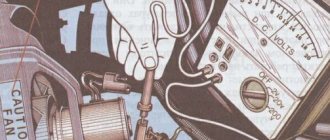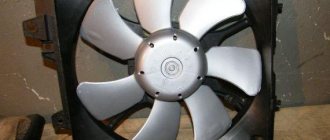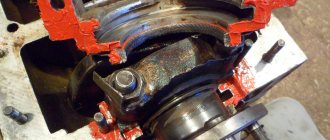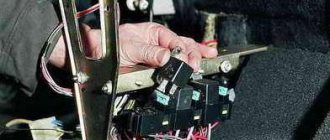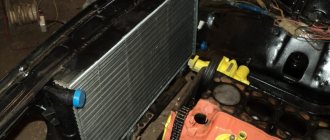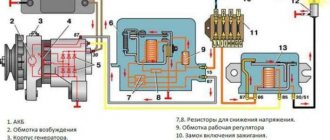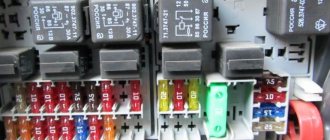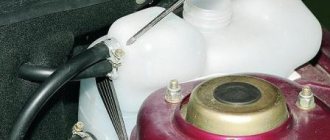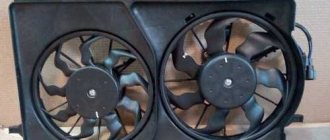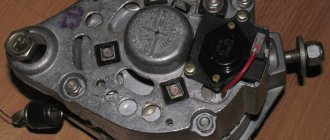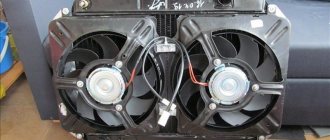For efficient operation of the engine, appropriate thermal conditions are required. When fuel burns, not only exhaust gases are released, which ensure the operation of the engine, but also thermal energy. To avoid engine overheating, it is cooled using various liquids (antifreeze, antifreeze, distilled water). The fan is necessary to reduce the temperature of the coolant.
TYPES OF COOLING FANS
There are four types of fans:
- with direct drive from the timing belt (chain);
- with direct drive from the alternator belt;
- driven by a timing belt or generator and a thermal coupling;
- with electric drive.
A fan directly driven by a timing belt or chain was used on cars that were produced before the nineties of the last century. Moreover, foreign car manufacturers abandoned such a system back in the seventies of the last century. The only dubious advantage of such a drive is the smaller number of belts, because the timing drive covered the pump, fan, crankshaft and camshaft. Often in such systems, the belt or chain was tensioned using a water pump (pump) without installing the adjusting roller.
A fan driven by an alternator belt became more widespread on inexpensive cars produced before the 2000s. Compared to timing belt/chain drive, this system has several advantages. The main one is the lack of influence of the fan on the operation of the timing system. In the event of a fan jam or other malfunctions, the operation of the timing belt is not disrupted and the car can continue to move under its own power.
A fan with a thermal coupling, regardless of the type of drive, has the main advantage - it better controls the thermal regime of the motor. Until the clutch is heated, it weakly transfers rotational energy to the fan, so even at maximum engine speeds its rotation speed is low. As the clutch heats up, the transmission coefficient increases and the fan rotation speed becomes increasingly dependent on engine speed. Therefore, when the engine warms up, the fan reduces the temperature of the coolant slightly, and when it heats up close to maximum, its operating efficiency increases.
An electrically driven fan is the most efficient and is used on most modern cars. It turns on only at a certain coolant temperature, thanks to which the engine quickly heats up and operates in a comfortable mode.
Diagnosis of cooling fan faults
Neither the most innovative electric motor with high power, nor the ultra-reliable control unit or controller is able to protect the cooling system one hundred percent from breakdowns. Considering that a failed cooling fan that blows in the wrong direction or does not rotate at all can cause engine overheating, it is necessary to constantly monitor its normal functioning.
Timely repair of system components will save your car from many troubles, but it is important to correctly determine the cause of the fan failure. In other words, you first need to find a problem where, for example, the crankshaft speed controller or control unit or electric motor does not work. Any driver can diagnose fan malfunctions based on the recommendations below.
The check should begin by dismantling the connector (plug) of the temperature sensor and inspecting it. In cases where the sensor is single, you need to take a small piece of ordinary wire and close the terminals in the plug. If the fan is working properly, the control unit or relay should give a command to turn it on when closed. If the device we are interested in does not turn on during such a test, this means that it requires repair or replacement.
If there is a double temperature sensor, the testing principle changes slightly and is performed in two stages:
- The red and red-white wires are closed. In this case, the fan should rotate slowly.
- Red and black wires are connected. The rotation should now speed up significantly.
If rotation is not observed, the fan will have to be removed and a new device installed in its place. If the radiator cooling fan is constantly running (blowing without interruption), there is a possibility that the sensor for its activation has failed. It is not difficult to verify this suspicion. You must turn on the ignition and then remove the wire tip from the sensor.
If the device does not turn off after this, you can safely buy a new regulator (sensor) for turning off the device. Situations where the radiator cooling fan is constantly running are not uncommon, and now you know how to solve this problem. It also makes sense to check the fuse in cases where you doubt the functionality of the mechanism described in the article. This is done like this:
- from the positive terminal of the battery, power is supplied to the red-black or red-white wires in the fan connector;
- From the negative terminal a charge is supplied to the brown wire.
If the regulator or unit does not respond (the device does not turn on), check the temperature sensor wire (all connectors and plugs on it). The cable may need simple repairs (for example, insulating it, replacing the plug). If the problem is not in the wire, then you will have to purchase a new fan, since yours is broken.
ELECTRIC COOLING FAN OPERATION SYSTEM.
When the fan heats up, the thermal switch sensor (located in the lower left corner of the radiator) closes a low-current circuit going to the unloading relay. I note that this sensor breaks the “minus” going to the relay. The “plus” relay comes from the ignition switch and is regulated by fuse No. 19 (located inside the car on the left in the instrument panel). The sensor is most often 3-pin. The brown wire takes the negative wire from the car body. The other two wires (striped), when the contacts in the sensor are closed on them, supply a “minus” to the unloading relay. Depending on the degree of heating of the coolant, the sensor closes a circuit going to relay No. 214 (first speed) or a circuit going to relay No. 217 (second speed). Relay No. 272 and temperature sensors located on the upper pipe of the cooling system (blue and gray) do not participate in any way
, contrary to popular belief.
Relay No. 272 only works when the ignition is turned off in the aftercooling mode (I will not touch this mode). Further, when receiving a “minus” from the sensor and a “plus” from the ignition switch, the unloading relay closes the power contacts and supplies “PLUS” directly to the cooling fan. The “MINUS” fan is taken from the car body (from the side member). The power “PLUS” relay is taken from the battery under the protection of a 40A fuse (60A if there are 2 fans on the radiator), which is located behind the decorative trim to the left of the driver’s foot (you won’t find it, and if you find it, you won’t get it). Well, that's all. Depending on which relay receives “minus” from the sensor, this speed will turn on.
Radiator fan malfunctions and their consequences
The main task of the engine fan is to “suck” cooled air from the outside through the radiator into the engine compartment of the car. In fact, cooling is carried out by a liquid system, and blowing only speeds up this process. On the other hand, at high ambient temperatures, as well as when the car sits for long periods in traffic jams without additional cooling, the engine can become very hot. This means that the serviceability of this unit should not be neglected.
Engine fans with different numbers of blades
Main malfunctions of the engine cooling fan:
- Doesn't turn on. Such a malfunction may be the result of a breakdown of the fan drive (broken belt, destruction of the clutch, faulty electric motor, oxidation of contacts) or inaccurate operation of the temperature sensor.
- Continuous operation and the impossibility of turning off until the vehicle stops completely (except for cars with a mechanical drive). Most often, such a breakdown is associated with a malfunction of the temperature sensor (thermostat) or jamming of the clutch.
- Untimely switching on. Turning on earlier is usually not a problem. If startup occurs late, a temperature sensor may be installed that is designed for operation at low temperatures (for example, the car is not suitable for regions with hot climates). In this case, the sensor must be replaced.
- Reverse direction of air injection. Occurs when the motor poles are connected incorrectly.
- Destruction of the impeller due to wear and increased loads.
When the cooling fan is correctly connected, the direction of air flow is always towards the engine.
Preventing the condition and cleaning the engine cooling radiator fan from dirt should be performed at least once a year. The cleaning procedure can be performed without dismantling the unit using conventional brushes. If replacement is required, it is better to contact specialized repair services, which will eliminate errors in diagnostics, selection of the desired fan configuration and its connection.
Radiator fans - purpose and design
The radiator cooling fan is used for air cooling, which, together with liquid cooling, ensures optimal temperature conditions for the engine. To increase the efficiency of liquid cooling, a radiator is used: oncoming air passes through its cells and cools the liquid. But at low speeds or in city traffic jams, the air flow is insufficient. To avoid overheating, a fan is turned on, which directs air to the radiator, cooling it.
On older models and modern SUVs with a longitudinally mounted engine, a mechanical cooling fan drive is used. In older cars it works constantly; later they began to install a viscous coupling, which turns it off if necessary. Used on large trucks and SUVs. The advantage is that it is not afraid of water, unlike electric fans.
Electric cooling fans test
With the onset of summer, some motorists are faced with the need to replace the electric cooling fan. How not to make a mistake with the choice of such an important component, on which the issue of engine “survival” in traffic jams and in hot weather often depends?
The electric fan produced by the Kaluga Automotive Electrical Equipment Plant (KZAE) model 70.3730 actually has a much wider application. It can be installed on the engines of almost all domestic cars (ZAZ, VAZ, AZLK, IZH, GAZ and ZIL). The main thing is that its parameters are suitable - 110 W and 2600 min-1, as evidenced by the corresponding inscription on the packaging and the installation drawing. KZAE mod. 70.3730 has an 8-blade impeller without a rim, unlike its competitors in the test. It is packed in a cardboard box. However, apart from the electric fan, nothing else could be found in it. The manufacturer's guarantees were also unknown.
Before we started testing the electric fan, we measured the diameter of the impeller (see table at the end of the article). The next step was to measure energy consumption and impeller rotation speed. The measurements were carried out in two modes: at the moment of start-up and during steady operation. Based on the measurement results, it turned out that the test subject was the most “economical” among competitors, but the impeller rotation speed turned out to be the lowest.
Having completed the measurements, we began disassembling the fan. The KZAE electric fan impeller has the same mounting as PEKAR and Kraft, and they can be interchangeable with each other. It is held on the shaft using pins, which are inserted into a through hole on the shaft of the electric motor. The impeller is secured with a regular nut and washer. The KZAE electric motor is dismountable, unlike the LUZAR fan. It is structurally made with two bearings: on one side the shaft rests on a ball bearing, on the other on a bushing (see photo). This collapsible design is more preferable from the point of view of maintainability. The electric motor brushes have a cross-section of 6.5x6.5 mm and a length of 11 mm. The connection of the brush units is made using wires. In this case, mediocre soldering was discovered.
The electric fan from St. Petersburg auto parts manufacturer PEKAR is much more specific, since it has an address message in the form of catalog number 2103-1308008. It also has an 8-blade impeller and rim to reduce vibration and noise. In addition to the packaging, a technical data sheet and fasteners for mounting the electric fan were included in the cardboard box. Manufacturer's warranty is two years.
Having carried out measurements as with the previous test subject, we disassembled the fan. The PEKAR electric fan impeller, as already noted, has the same mounting with KZAE and Kraft and can also be interchangeable with each other. It is held on the shaft by pins inserted into a through hole on the motor shaft. The impeller is secured with a nut with a lower toothed rim. The electric motor is also structurally made with two bearings. The cross section of the brushes is 6.5x6.0 mm, length - 11 mm. The brush units are connected using wires, just like in KZAE, but the soldering of the wires is performed at a more technological level. The electric fan under the German brand Kraft (KT 104500) is exactly like the one from St. Petersburg. At the same time, we experienced a certain feeling of déjà vu. Exactly the same impeller and engine dimensions. However, this is where the similarity ends: no passport, no fasteners, and the warranty is only one year. Having measured the diameter of the impeller (note that for fans with a rim, the diameter of the impeller was measured along the inner rim), as well as the energy consumption and rotation speed of the impeller, we began to disassemble this fan and found complete similarities with the PEKAR electric fan.
The LUZAR electric fan is strikingly different from its counterparts with eight profile blades united by a single rim. In addition to the fan, we found a technical data sheet and fasteners in the cardboard box. The warranty for this electric fan is two years. Based on the results of measurements of energy consumption and impeller rotation speed, the fan turned out to be in the “golden mean”. At the same time, it has the highest impeller rotation speed.
Analysis showed that the impeller of the LUZAR electric fan is held by a groove on the electric motor shaft and is fixed with a nut with a left-hand thread that has a lower toothed rim. In addition, the nut is secured with a thread locker. Due to this, the impeller of the LUZAR electric fan is not interchangeable with other electric fans. The LUZAR electric motor is also made according to a two-bearing design, like the previous tests, but on two ball bearings. It follows from this that collapsible structures are more preferable from the point of view of maintainability, at the same time, two bearings on the shaft make the structure more reliable and durable. Let's move on to the brush assembly. The electric motor of the LUZAR fan uses spark arresting chokes (twisted copper wire). This design significantly extends the life of the product. The cross section of the brushes is 7.0x8.0 mm with a length of 20 mm. The connecting wires of the brushes also have a larger cross-section (help reduce heating). To connect the brush assemblies and spark-extinguishing chokes, brass plates are used, to which the supply wires and brush wires are welded with special conductive welding pliers (in all likelihood, this leads to a decrease in transition resistance and less heating).
When examining all four rotors in the LUZAR fan electric motor, a double rotor winding was discovered. Its use precisely leads to increased magnetic flux and electric motor power with the same dimensions. Comparability of prices for the tested fans revealed some inadequacy in the supply of goods according to the “price-quality” criterion. A higher price is requested for frankly low quality. If we take into account the data obtained during testing, we are inclined to give our preferences in favor of the LUZAR fan.
Viscous coupling fans
A system based on a viscous coupling is not common. It is equipped with vehicles with a longitudinally mounted power unit, and it is also used on large SUVs used to overcome water obstacles. This is due to the operating principle of such a cooling fan. The viscous coupling is a completely sealed design and is therefore reliably protected from water penetration. Under its influence, electrical systems will instantly fail. The viscous coupling is filled with special silicone oil or gel. It changes its properties when exposed to temperatures. The rotation speed of the device will be reduced or increased depending on the heating level. This cooling fan consists of a sealed housing filled with silicone liquid, as well as drive and driven shaft disk packages. The operating principle is based on the transmission of rotation from the drive to the driven shaft due to disk packs.
The principle of operation of an internal combustion engine cooling fan
In order for the fan to operate when necessary, it is connected to another system that monitors the working environment. Depending on the modification, its device includes a coolant temperature sensor and a fan relay. This electrical circuit is connected to the fan motor.
This simple system works as follows. A sensor installed at the radiator inlet records the coolant temperature. As soon as it rises to the appropriate value, the device sends an electrical signal to the relay. At this moment, the electromagnetic contact is triggered and the electric motor is turned on. When the temperature in the line drops, the signal from the sensor stops coming and the relay contact opens - the impeller stops rotating.
In more advanced systems, two temperature sensors are installed. One is at the coolant inlet to the radiator, and the other is at the outlet. In this case, the fan is turned on by the control unit itself, which determines this moment by the difference in indicators between these sensors. In addition to this parameter, the microprocessor takes into account the force of pressing the gas pedal (or opening the throttle ), engine speed and readings of other sensors.
Some cars use two fans to improve the performance of the cooling system. The presence of an additional rotating element allows for faster cooling of the heat exchanger due to a greater flow of cool air. Such a system is also controlled by the control unit. In this case, more algorithms work in the microprocessor. Thanks to this, the electronics can not only change the speed of rotation of the blades, but also turn off one of the fans or both.
